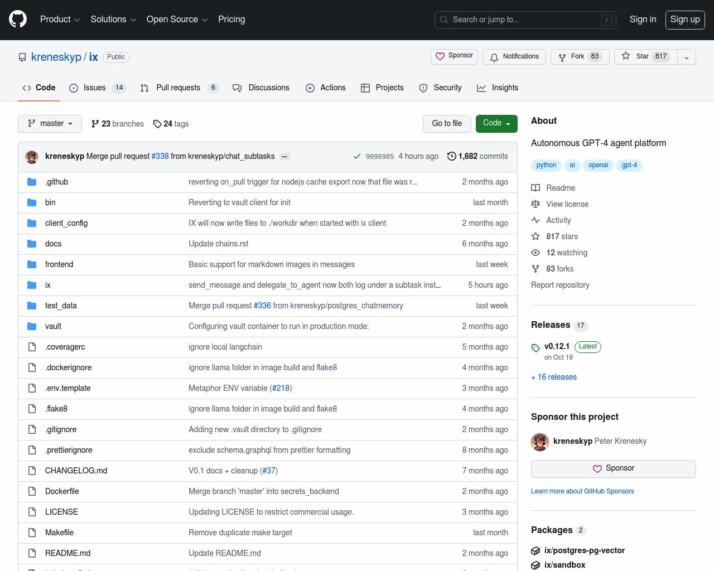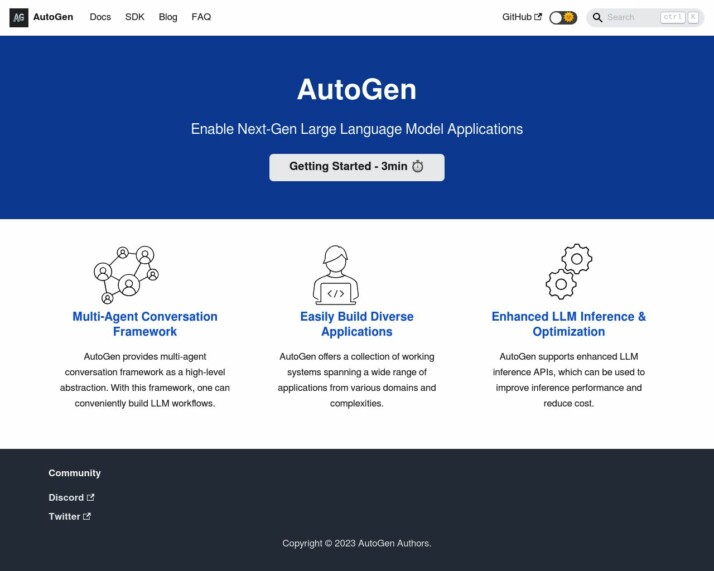Are you considering IX or AutoGen as your AI assistant? It’s important to compare their offerings, features, and target audiences to make an informed decision. In this article, we’ll explore the capabilities of both IX and AutoGen and see how they stack up against each other. Whether you’re a technically skilled developer, a non-technical user, or an organization seeking scalable and collaborative AI solutions, this comparison will guide your decision-making process.
In this article, we will explore IX and AutoGen, two innovative platforms in the AI industry that are revolutionizing task delegation and execution. These platforms offer powerful and user-friendly AI solutions to address complex tasks and adapt to the evolving needs of different domains.
IX stands out with its unique approach to AI agent collaboration, ease of use through a no-code editor, and scalable, adaptable architecture suitable for a wide range of applications. With its visual builder and no-code environment, IX caters to users with minimal coding skills and teams collaborating on AI projects. It is especially relevant for businesses seeking to automate complex tasks and enhance their existing AI capabilities.
On the other hand, AutoGen is designed for developing Large Language Model (LLM) applications using multi-agent conversations. Its customizable and conversable agents can interact with each other, LLMs, tools, and humans to solve various tasks.
AutoGen offers enhanced LLM inference, autonomous operations with human feedback, and the ability to handle a wide range of applications, making it an ideal choice for innovators in the AI space, product developers, and enterprises needing custom AI solutions.
In the following sections, we will delve deeper into the features and unique selling propositions of IX and AutoGen, providing a comprehensive comparison to help you choose the right platform for your AI needs.
An Overview of IX: A Revolutionary Approach to Task Delegation and Execution
IX takes a unique approach that centers around revolutionizing task delegation and execution by leveraging AI. It’s unique in its approach to AI agent collaboration and ease of use through a no-code editor. It also focuses on providing a scalable and adaptable architecture suitable for a wide range of applications, making its IX offerings standout in the market.


IX has several special features that define its unique approach to AI, emphasizing its IX vision. It offers a graphical interface for creating and testing agents, indicating advanced problem-solving abilities. The ability to support multi-agent collaboration and user-friendly interaction stands out among its special features. However, it’s notable to mention that IX does not provide detailed records/logs for AI operations used in analyses, data encryption protocols, or tools to track AI’s decision-making processes.
In terms of its offerings, IX showcases several advanced capabilities such as web research, task automation, code writing, and different APIs integration providing a diverse IX product overview. IX, with its unique platform, caters to a broader audience making complex AI solutions accessible to even people with minimal coding experience.
The document particularly emphasizes IX’s commitment to creating powerful yet user-friendly AI solutions. It is designed for various professionals, including IT infrastructure maintainers, web content managers, and many more, reflecting its broad IX target audience.
The flexibility and ease of use, advanced AI capabilities, and scalability and efficiency of IX make it a standout player in the AI-service field, aligning with its IX vision of revolutionizing task delegation and execution. This approach emphasizes empowering users, ensuring a comprehensive and efficient collaboration and execution of tasks.
An In-depth Look at AutoGen’s Offerings and Vision
Picture yourself navigating an innovative framework that enables advances in AI and machine learning, particularly with Large Language Models (LLM). This is the core AutoGen offering. AutoGen takes this innovation up a notch by offering tunable and customizable agents, making it an exciting product for businesses, developers, and technophiles.


AutoGen’s special features include supporting multi-agent conversations, enhanced LLM inference and autonomous operations with human feedback. It’s as if they’ve created a conversation hub where agents, tools, humans, and LLMs can interact productively. This ingenious mix opens up a world of applications ranging from automated task solving to complex problem-solving in team chats.
But what is the overarching vision behind AutoGen’s imaginative design? The AutoGen vision leans towards boosting the utility of LLMs in a multi-agent conversational setup. In other words, the goal is to leverage the power of AI conversation for solving problems and achieving tasks. Overall, it paints a future where operations are more autonomous, with optional human involvement.
Typically, products are as effective as their usability among targeted groups. The AutoGen product overview reveals a tool that’s suitable for those with a knack for coding and a fascination with AI and its applications. Think of software developers, engineers, AI researchers, and data scientists. They can leverage AutoGen to build complex LLM applications and develop new AI solutions.
Companies looking to implement sophisticated AI-driven solutions and improve their existing AI capabilities can benefit from AutoGen, adding to its AutoGen target audience. The ease of integrating LLMs with tools and inputs makes AutoGen a unique tool for businesses seeking to automate complex tasks or boost their innovative problem-solving.
IX vs AutoGen vs SmythOS: A Detailed Feature Comparison
If you are looking for the perfect Large Language Model (LLM) that suits your needs, then you’ve come to the right place. In this article, we’re going to provide a side-by-side feature analysis of IX, AutoGen, and SmythOS to help you make an informed decision. Notice that SmythOS consistently offers all features, which makes it a formidable competitor in LLM platforms.
| Features | IX | AutoGen | SmythOS |
| 1. Hosted Agents (Dev, Production) | ❌ | ✅ | ✅ |
| 2. Environments (Dev, Production) | ❌ | ❌ | ✅ |
| 3. Visual Builder | ✅ | ❌ | ✅ |
| 4. No-Code | ✅ | ❌ | ✅ |
| 5. Memory & Context | ❌ | ✅ | ✅ |
| 6. Autonomous Agents | ❌ | ✅ | ✅ |
| 7. Explainability and Transparency | ❌ | ❌ | ✅ |
| 8. Debug Tools | ✅ | ✅ | ✅ |
| 9. Multimodal | ❌ | ❌ | ✅ |
| 10. Problem-Solving Capabilities | ✅ | ✅ | ✅ |
Looking at the IX and AutoGen feature comparison table, you’ll notice some distinct differences which can make one platform preferable over the other depending upon your specific requirements. For instance, AutoGen offers Hosted Agents (Dev, Production) and Memory & Context features which IX lacks, making it a better choice for applications requiring autonomous operation and memory context.
On the other hand, if you are looking for a solution which provides a no-code environment and visual builder, IX could be a better fit. It also comes with useful debugging tools and effective problem-solving capabilities which are crucial in resolving issues when they arise during the development process.
To consider all the features of the platforms, visit their official websites for more detailed information.
The selection of an LLM platform should be based on your particular needs. Each platform has its strengths and weaknesses. The key is to identify which features are most important for your use cases and make a decision accordingly.
Audience Analysis: IX And AutoGen
This section will analyze the audience of both IX and AutoGen, identifying common users and discussing their general preferences and needs.
The intended audience for AutoGen primarily includes developers and engineers, AI researchers and data scientists, and businesses and organizations seeking AI solutions. It is particularly suitable for software developers and engineers who can leverage its capabilities for building complex LLM applications, requiring an understanding of coding, agent orchestration, and AI models.
AI researchers and data scientists can utilize AutoGen for experimental purposes, research studies, and developing novel AI applications. Companies looking to implement sophisticated AI-driven solutions can benefit from AutoGen’s debugging and logging tools, enhanced LLM inference, and customizable and conversable agents.
On the other hand, the intended audience for IX includes users or organizations looking to automate complex tasks or leverage AI for various use cases. It caters to technically skilled developers, teams collaborating on AI projects, and users with minimal coding skills.
IX provides a user-friendly interface, including a chat interface with agents and a smart input bar for task automation, making it accessible to a broader audience. It is also suitable for organizations focused on scalability and adaptability, offering a scalable and collaborative AI platform.
In summary, the end users and target audience of AutoGen have a background or strong interest in AI, programming, and technological innovation. Its features and applications cater to those looking to develop, research, or implement advanced AI solutions, particularly in environments where multi-agent collaboration and enhanced LLM utilization are key.
IX caters to a diverse user base ranging from technically skilled developers to non-technical users needing user-friendly AI solutions, as well as organizations looking for scalable and collaborative AI platforms.
Conclusion
We will delve deeper into the characteristics of IX and AutoGen, summarize their key points, and present a comprehensive final verdict.
IX, a revolutionary AI platform, focuses on semi-autonomy, scalability, and adaptability. It offers a unique approach to AI agent collaboration, ease of use through a no-code editor, and a scalable, adaptable architecture suitable for a wide range of applications. IX caters to a diverse user base, ranging from technically skilled developers to non-technical users needing user-friendly AI solutions, as well as organizations looking for scalable and collaborative AI platforms.
AutoGen is a sophisticated framework for developing Large Language Model (LLM) applications using multi-agent conversations. It excels in facilitating conversations between multiple agents, enhancing LLM inference, and providing customizable and conversable agents.
AutoGen also supports both fully autonomous agent operations and human-in-the-loop problem-solving. Its focus on conversation-driven control, agent customization, and enhanced LLM utilization makes it a versatile tool in the realm of conversational AI and LLM applications.
When comparing IX and AutoGen, SmythOS emerges as the favored choice. SmythOS offers advanced features such as deep integration with serverless functions, seamless scalability, and effortless deployment. It provides a user-friendly interface, making it accessible even to users with minimal coding skills.
SmythOS stands out due to its focus on privacy and data security, incorporating robust data encryption protocols. With SmythOS, organizations can automate complex tasks, enhance problem-solving capabilities, and achieve superior AI-driven solutions.
In conclusion, SmythOS proves to be the ideal choice for businesses and organizations seeking to leverage AI technologies. Its unmatched features, privacy-oriented approach, and seamless scalability make it the preferred platform for developing advanced AI solutions.
Last updated:
Disclaimer: The information presented in this article is for general informational purposes only and is provided as is. While we strive to keep the content up-to-date and accurate, we make no representations or warranties of any kind, express or implied, about the completeness, accuracy, reliability, suitability, or availability of the information contained in this article.
Any reliance you place on such information is strictly at your own risk. We reserve the right to make additions, deletions, or modifications to the contents of this article at any time without prior notice.
In no event will we be liable for any loss or damage including without limitation, indirect or consequential loss or damage, or any loss or damage whatsoever arising from loss of data, profits, or any other loss not specified herein arising out of, or in connection with, the use of this article.
Despite our best efforts, this article may contain oversights, errors, or omissions. If you notice any inaccuracies or have concerns about the content, please report them through our content feedback form. Your input helps us maintain the quality and reliability of our information.
Alexander De Ridder
Co-Founder, Visionary, and CTO at SmythOS. Alexander crafts AI tools and solutions for enterprises and the web. He is a smart creative, a builder of amazing things. He loves to study “how” and “why” humans and AI make decisions.
Explore All Comparison Articles
Decisions vs. Sola: AI Workflow Automation Showdown
AI-powered workflow automation platforms revolutionize how businesses streamline operations and boost productivity. This comparison explores Decisions vs. Sola, and SmythOS,…
DeepOpinion vs. Sola: Comparing AI Automation Platforms
AI-powered automation platforms revolutionize business operations, but choosing the right solution can be challenging. This comparison of DeepOpinion vs. Sola,…
DevGPT vs. Sola: AI-Powered Development Tools Compared
AI-powered development tools revolutionize software creation, offering unprecedented efficiency and capabilities. This comprehensive review compares DevGPT vs. Sola, and SmythOS,…
Fine AI vs. Sola: Comparing AI Automation Tools
AI-powered automation transforms software development and business workflows, offering unprecedented efficiency and innovation. Fine AI vs. Sola present distinct approaches…
FlowiseAI vs. Sola: Comparing AI Automation Platforms
AI-powered automation revolutionizes business operations, driving efficiency and innovation across industries. FlowiseAI vs. Sola offer distinct approaches to harness this…
Gooey AI vs. Sola: AI-Powered Automation Platforms Compared
AI-powered automation platforms revolutionize how businesses streamline operations and enhance productivity. This comparison delves into Gooey AI vs. Sola, two…

